Self–compacting Concrete A Paradigm Shift
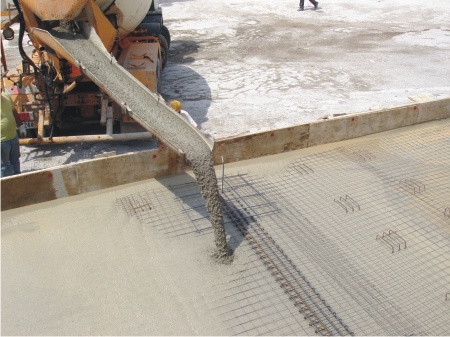
S. K. Singh, Scientist, Central Building Research Institute, Roorkee & Honorary Secretary, Institution of Engineering Roorkee Centre.
In the era of highrise and over congested construction sites, the performance required for concrete structures is becoming more and more complicated and diversified. The concrete is required to have properties like high fluidity, self-compactability, high strength, high durability, better serviceability and long service life. The construction activity should have minimal interference with the environment. Self-compactability is desirable to attain rationalized and labor saving effects in production and placing of concrete. Self-compacting concrete (SCC) is a highly engineered material that addresses these requirements of high fluidity and no segregation. The several advantages reported in using SCC are reduction in the construction time and labor cost, elimination of the need of vibration, reduction of noise pollution, improving compactability even in highly congested structural members and finally a better construction ensuring good structural performance. This paper is the review of development in the field of SCC and its basic principle, different mix proportioning, properties in fresh and hardened state, testing methods to test high-flowability, resistance against segregation and its ability to pass through congested reinforcement. Mix design method and effect of incorporating variety of materials have been discussed in this paper. The applications of SCC, practical acceptance at jobsite and its future prospects have also been discussed.
Introduction
From several years, due to poor quality control and quality assurance at site, the problem of durability of concrete structures has been a major issue to engineers. Sufficient compaction is required to make durable concrete structures. Compaction of conventional concrete is done by vibrating whereas over vibration can easily cause segregation and bleeding. Also under vibration can cause honeycombing in concrete. Further, in conventional concrete, it is very difficult to ensure uniform material quality and good density in heavily reinforced locations of the structures. If steel is not properly surrounded by concrete it leads to durability problems. To overcome these problems, SCC was developed in Japan as a means to create uniformity in the quality of concrete. Self-compacting concrete achieves this by its unique properties in fresh state such as workability, water retention, workable time, green stability and early shrinkage. In the plastic state, it flows under its own weight and maintain homogeneity while completely filling any formwork and passing around congested reinforcement. Furthermore, in hardened state, it possesses all important properties such as compressive strength, flexural and tensile strength, elastic modulus, drying shrinkage, freeze-thaw resistance and carbonation resistance as compared to conventional concrete. The concept of SCC was firstly proposed and applied to prototype structure by Okamura [1] in Japan in 1988. Later studies to develop SCC, including a fundamental study on the workability of concrete, have been carried out by Ozawa and Maekawa [2]. SCC has now been used in construction with enthusiasm across Europe, America and other parts of the world in both cast-in-situ and precast concrete work. Earlier, SCC relied on very high content of cementitious paste and the mixes required specialized and well-controlled placing methods to avoid segregation. But the high contents of cement paste made them prone to shrinkage and generation of very high heat of hydration. The overall costs were also very high and therefore, applications remained very limited. After a continuous research and development which created a series of advancement in the field of SCC and it is now no longer a material consisting of only cement, aggregates, water and admixtures.The SCC is an engineered material consisting of cement, aggregates, water and admixtures with several new constituents like colloidal silica, pozzolanic materials, ground granulated blast furnace slag (ggbs), microsilica, metakaolin, chemical admixtures etc. to take care of specific requirements such as high-flowability, high compressive strength, good workability, enhanced resistance to chemical and mechanical stresses, lower permeability, enhanced durability, resistance against segregation and ability to pass under dense reinforcement conditions. The fluidity, deformability and high resistance to segregation enables the placement of concrete without vibrations and with reduced labour, noise and less wear and tear of the equipment. It also helps to shorten the construction period.
Basic Principle
The SCC is a concrete which gets compacted due to its self-weight and is de-aerated (no entrapped air) almost completely while flowing in the form work. In densely reinforced structural members, it fills completely all the voids and gaps and maintains nearly horizontal concrete level after it is placed. The above mentioned properties of SCC are achieved by limiting aggregate wherein energy required for flowing is consumed by internal stress (it is increased due to decrease distance between particles that is due to high deformability) resulting in blockage of aggregate particles. Limiting coarse aggregate content whose energy consumption is intense to a level lower than normal is effective in avoiding this type of blockage. The high flowability with high deformability can be achieved only by application of a super-plasticizer keeping w/p ratio to a very low value [3]. Fig.1 explains the process of achieving self compactability with the help of a flow chart.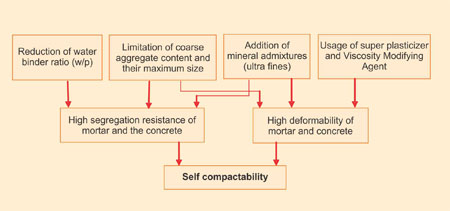
The reasons for better performance of SCC are attributed to better microstructure and homogeneity. Many investigations, carried out by means of efficient microscopes/SEM etc, have shown an improved microstructure of SCC opposite to conventional concrete. The void ratio of SCC in the interfacial transition zone between cement paste and aggregate has been found lower and the pores have been distributed much more evenly [1].
The Rheology of Self- compacting Concrete
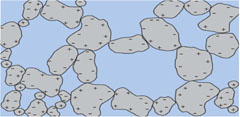
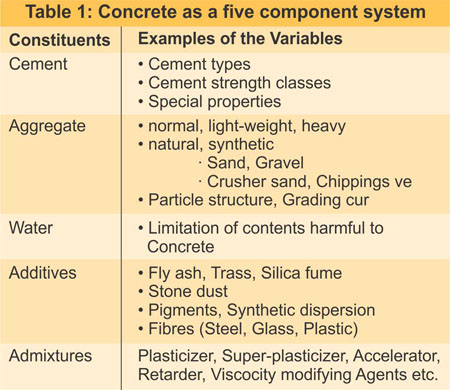
New developments in the field of super-plasticizers [6] exhibit that steric and tribological effects also plays an important role in the mobility of the individual solid particles. Polycarboxylates, for example, are being developed specifically with a correspondingly extended performance spectrum. Increased addition of super-plasticizer is always associated with a drop in yield value towards zero, but the dynamic viscosity of the suspension is governed largely by the water/solids ratio, i.e. by the average thickness of the water layer between the solid particles.
With addition of super-plasticizer, cement-fine solids with water/solids ratios of (for example, 0.6, 0.5 and 0.4), very soon reach the so-called "saturation point" after which no further reduction of the shear resistance can be measured [8]. Because of the large amount of water-filled free space around the disagglomerated solid particles these tend to settle as soon as the suspension is no longer stirred. The coarser particles sink faster than the finer ones in accordance with the laws of physics. The finer cement grains, which individually have already been substantially hydrated in the suspension, therefore only come into contact with one another after a fairly long period, and are no longer capable of developing the required solid hydrate structure with one another. They appear as a chalk-white surface layer. Concretes with excessively high additions of super-plasticizer and excessively low ultrafines content may then exhibit the typical faults during the production of such concrete.
Mix Proportioning
Before any SCC is produced and used at site the mix has to be designed and tested. In this process, local materials should be tested to achieve new concrete mixes with right mixing sequences and mixing time valid for the plant and also suitable for the element to be cast. Various kinds of fillers can result in different strength, shrinkage and creep but shrinkage and creep will usually not to be higher than for that of conventional concrete. Various mix proportions of SCC as shown in Table 2 have been used all over the world depending upon the locally available materials.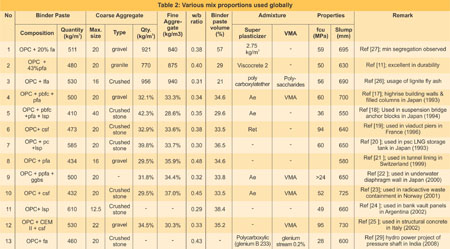
Mix Design Principles
The flowability and viscosity of the paste is adjusted and balanced by careful selection and proportioning of the cement and additives by limiting water powder ratio and then by adding a super plasticizers and Viscosity modifying agents. By controlling precisely these components of SCC, their compatibility and interaction, good filling and passing ability, resistance to segregation can be achieved. For controlling temperature rise and shrinkage cracking as well as strength, the powder ratio in the concrete can be increased. The paste is the vehicle for the movement of aggregate therefore the volume of the paste must be greater than void volume in the aggregate [4]. The coarse to fine aggregate ratio in the mix should be low to achieve a good passing ability between congested reinforcement.So SCC should have:-
- Low coarse aggregate content
- Increased paste content
- Low water powder ratio
- Increased super plasticizers dosage
- Sometimes VMA can be used
Super Plasticizers and Cementitious Materials
When we increase the slump of concrete over 175mm by increasing amount of water the bleeding increases too much but with superplasticizers flowing concrete with slump level up to 250mm can be manufactured with no or negligible bleeding. The most important basic principle for flowing and cohesive concrete (SCC) is the use of superplasticizers combined with a relatively high content of powder materials in terms of Portland cement mineral additions ground fillers and very fine sand. A particle replacement of Portland cement by fly ash is also good for theological properties (resistance to segregation, strength level and crack freedom) practically in mass concrete structures exposed to resistance thermal stresses produced by the heat of hydration of cement.Viscosity Modifying Agents (VMA)
With these admixtures (0.1 to 0.2% by mass of cementitious materials) SCC can be made with a reduced volume of fine materials. There are two types of VMA used:- Traditional pumping aids, admixtures used to improve the cohesiveness of lean concrete mixtures to be pumped and chemically based on modified cellulose or hydrolyzed starches
- Polithielen glycol and biopolymers which appear to be the most effective VMA's for SCC
Constituent Materials of SCC
The constituent materials for SCC are same as in the case of conventional concrete except specific addition and chemical admixtures to achieve flowability and performance [29].Cement
All cements which confirms any type of standard can be used for the production of SCC. However, correct choice of cement type depends on the specific requirements of application rather than the specific requirement of SCC.Addition
Due to fresh property requirements of SCC, inert and pozzolanic or hydraulic additions are commonly used to improve and maintain the cohesion and segregation resistance. Additions are also limiting the cement content in order to reduce the heat of hydration and thermal shrinkage.Mineral fillers: The particle size distribution shape and water absorption of mineral fillers may affect the water demand or sensitivity. CaCO3 based minerals fillers (<0.125mm size) are widely used and can give excellent rheological properties and performance.
Fly ash: It enhances cohesion and reduces sensitivity to changes in water content. However, high levels of fly ash may produce a paste fraction which is so cohesive that it can become resistant to flow.
Silica fume: Silica fume or microsilica (very fine amorphous silica particles <1 micron) is complementary material to manufacture concrete with great cohesion in fresh state. Due to high fineness, spherical shape and amorphous nature of silica fume it gives good cohesion, improved resistance to segregation and high reactivity to SCC. Silica fume is also very effective in reducing or eliminating bleeding.
Ground blast furnace slag: It provides reactive fines with a low heat of hydration. GGBS is already exists in some type of cements. A high proportion of GGBS may affect stability of SCC resulting in reduced robustness with problems of consistence control while slower setting can also increase the risk of segregation.
Marble powder: It enhances segregation resistance to the concrete and when marble powder is used in dry form it absorbs moisture also.
Other additions: Metakaolin, natural pozzolana, ground glass, air cooled slag and other fine fillers have also been used or considered as additions for SCC.
Fine Aggregates
In order to ensure sufficient workability while limiting the risk of segregation or bleeding, SCC contains a large amount of fine particles (around 500 kg/m3). Nevertheless, high volume of paste in SCC mixes helps to reduce the internal friction between the fine aggregate particles but well graded sand is still very important. In order to avoid excessive heat generation the Portland cement is generally replaced by mineral admixtures like lime stone fillers and fly ash. Nature and amount of fillers added are cohesive in order to comply with the strength and durability requirements.Coarse Aggregates
It is possible to use natural rounded semi crushed or crushed aggregate to produce SCC, with maximum aggregate size varying from 10 to 20mm. Their content is kept sufficiently low so that individual aggregate to be lubricated by a layer of mortar paste, thereby increasing the fluidity and reducing segregation potential. The reinforcement spacing is deciding factor in determining the maximum aggregate size in SCC.Admixtures
Super plasticizers or high range water reducing admixtures are essential components of SCC. Viscosity Modifying Agent (VMA) may also be used to reduce the segregation and sensitivity of the mix due to variation in other constituents especially to moisture content.Superplasticizers: The admixture should bring about the required water reduction and fluidity but should also maintain its dispersing effect during the time required for transport and application. Precast concrete is likely to require shorter retention period as compared to cast-in-situ.
VMA: VMA significantly increases cohesive property of SCC without altering its fluidity. These admixtures reduce the effect of variations of moisture content.
Air entraining admixtures: It increases freeze-thaw durability of SCC. They are also used to improve the finishing of flat slabs.
Fibres
Both metallic and synthetic fibres have been used in the production of SCC. Due to the use of fibres flowability and passing ability of SCC can be reduced. Trials are therefore needed to establish the optimum type, length and volume fraction to give all the required properties in the fresh and hardened state.Mixing Water
Same water may be used as used for simple concrete. Where recycled water recovered from processes in the concrete industry is used the type/content and in particular any variation in content of suspended particles should be taken into account as this may affect the batch uniformity of mix.Properties of SCC
Structural Properties
The basic ingredients used in SCC mixes are practically the same as those used in the conventional concrete, except they are mixed in different proportions and the addition of special admixtures to meet the project specifications for SCC. The hardened properties are expected to be similar to those obtainable with conventional concrete. Laboratory and field tests have demonstrated that the SCC hardened properties are indeed similar to those of conventional concrete as shown in Table 3.
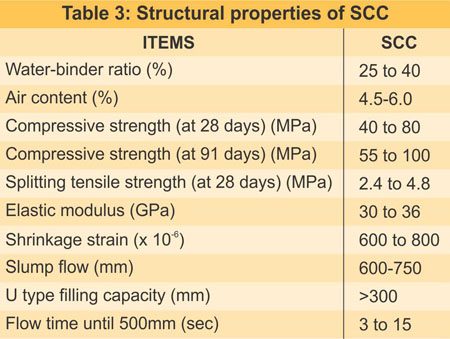
Development of Concrete Strength with Time
The difference between 28 days compressive strength of SCC and conventional concrete is not very pronouncing. Isolated cases however showed that at the same water cement ratios slightly higher compressive strengths of SCC is obtained. Some of the published test results show that an increase of the cement content and a reduction of filler content at the same time increase the initial compressive strength and the ultimate concrete strength [12]. The strength development of SCC is studied for various percentage of replacement of additions (fly ash) and results are shown in Fig. 3.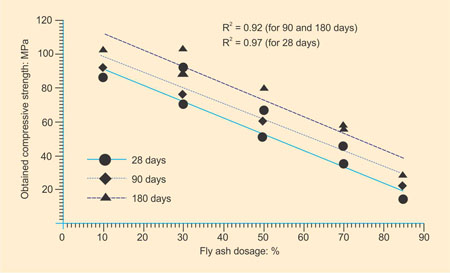
Splitting Tensile Strength
All parameters which influence the characteristics of the microstructure of the cement matrix and of the interfacial transition zone are of decisive importance in respect of the tensile load bearing behaviour. Most of the results of the measured splitting tensile strength values are in the range of valid regulations for conventional concrete with the same compressive strength[13]. However, in about 30% of all data points a higher splitting tensile strength has been found (Fig. 4).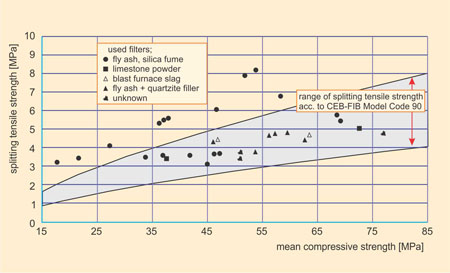
Hence SCC appears to have higher tensile strength. The reason is better microstructure, especially the smaller total porosity and the more even pore size distribution within the transition zone of SCC. Further, a denser cement matrix is present due to the higher content of ultra fines. Only few examples about SCC show more rapid increase of the tensile strength as compared to the corresponding compressive strength.
Modulus of Elasticity
The modulus of elasticity of concrete depends on the proportion of the Young s modulus of the individual components and their percentages by volume. Thus, the modulus of elasticity of concrete increases for high content of aggregates (of high rigidity), whereas it decreases with increasing cement paste content and increasing porosity. It is seen that the modulus of elasticity of SCC can be up to 20 % lower compared with conventional concrete having the same compressive strength and made of the same aggregates [13].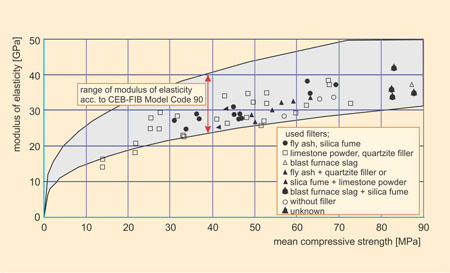
Shrinkage and Creep
SCC is affected in the same way as conventional concrete by the water cement ratio as well as the kind of specimen curing. The drying shrinkage of SCC has been examined several times. The shrinkage deformations can achieve higher values in SCC than in comparable conventional concrete. A large influence on the shrinkage deformations result from the aggregate combination, the relation of coarse to fine aggregates, fineness and content of ultra-fines. So the shrinkage can be reduced by a higher content of coarse aggregates. However, a minimum paste volume must be present, in order to ensure an optimal self-compaction of SCC without segregation. Furthermore, a denser microstructure of the cement paste can be achieved by addition of fillers with fineness larger than that of cement. It is seen that the drying shrinkage of SCC is 10 to 50% higher than that of conventional concrete. There is a steep rise of the deformations particularly for young concrete aged up to 28 days, which decreases again with an increasing age. As regard to creep behavior of the concrete, results are contradictory. Therefore more results are needed to establish creep behavior of SCC.Bond Behavior
The bond between reinforcement and concrete is influenced by parameters of reinforcing bar and surrounding matrix. In SCC the main factors are the grading of the aggregates and the ultrafine material content, the consistency and application of superplasticizer and stabilizer. It is observed that a lower maximum bond strength, but a higher bond stiffness in the range of low displacements. After reaching the maximum bond stress the slip increases gradually but the bond stress decreases extremely low. In general the bond strength is dependent on the position of the reinforcing bar in the formwork (top bar effect), and the height of fresh concrete above and beyond the bar during casting. SCC shows a lower settlement in the formwork due to self-deaeration during flowing in comparison to conventional concrete [12].Coefficient of Oxygen Permeability
The SCC mixes have significantly lower oxygen permeability coefficient than the conventional reference concrete mixes. Particularly, for SCC mixes using PFA and limestone powder the coefficient of permeability is only 30 - 40% of the level for the reference concrete mixes.Sorptivity - Capillary Water Absorption
The research indicates that sorptivity was considerably lower for all the SCC mixes than for the traditional vibrated reference mixes. Such results would suggest that the near-surface concrete was denser and more resistant to ingress of fluid in the SCC mixes than in the corresponding reference mixes [14].Chloride Diffusivity
Chloride ingress into concrete is one of the most common causes of durability problems, particularly corrosion of reinforcement in structural concrete. The ingress of chloride into concrete may be by permeation and capillary absorption of chloride-containing solutions or by diffusion of chloride ions through saturated internal network of pores in concrete. SCC mixes show similar chloride diffusivity to those of traditional vibrated mixes. However, the chloride diffusivity was found to be very much dependant on the types of powder used in concrete. Both the reference and SCC mixes containing PFA showed much lower values of coefficient of chloride migration than the other mixes.Micro-Properties of Interfacial Transition Zone around Steel Reinforcement
The interfacial transition zone (ITZ) between cement paste and reinforcement (i.e. aggregates and steel bars) has been recognized as being the 'critical and weak link' in cement composites and structural concrete, and having a considerable influence on the engineering and durability properties. In order to assess the impact of the use of SCC on bond and durability performance, the micro-properties of the ITZ around steel reinforcement was studied using a novel depth-sensing micro indentation test [10]. The research indicates that the average elastic modulus and micro hardness values of the ITZ were higher in the SCC mix than in the corresponding traditional vibrated reference mix. As expected, the ITZ properties below steel bar were found to be relatively weaker than those above the bar, likely to be caused by internal bleeding and settlement of the fresh concrete during the placing and compaction processes. However, the results seemed to indicate that the difference of ITZ properties between top side and bottom side of the steel bar was less pronounced for the SCC mix than for the reference mix [11].Test Methods for Flowability of SCC
The Slump Flow Test
This is a test method for evaluating the flowability of SCC, The basic equipment is the same as for the conventional slump test. However, the concrete placed into the mold is not rodded. When the slump cone has been lifted and the diameter of the spread is measured rather than the vertical distance of the collapse, as shown in the Fig. 6.
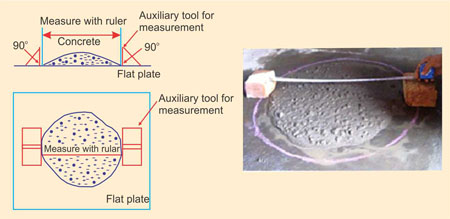
Funnel Test
The V-funnel test was developed in Japan and used by Ozawa [28]. In this test method, segregation resistance of SCC is being evaluated using a funnel as shown in Fig. 7. The funnel is filled with concrete and the efflux time of SCC with coarse aggregates having the maximum size of less than 25 mm is measured.This test gives account of the filling capacity (flowability). The inverted cone shape shows any possibility of the concrete to block is reflected in the result.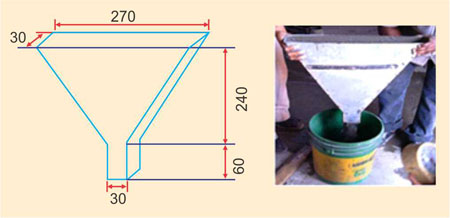
T500 Test
This is also a test method for evaluating the material segregation resistance of SCC, where the 500-mm flow reach time is measured in the slump flow test as shown in Fig. 6. SCC should give 500 = 2 - 5 seconds.U-Type and Box-Type Tests
In this method, flowability of SCC with coarse aggregates having the maximum size of less than 25 mm is measured by passing it through an obstacle (Fig. 8). Time is measured to pass SCC through the obstacle for self-compactability [15,16].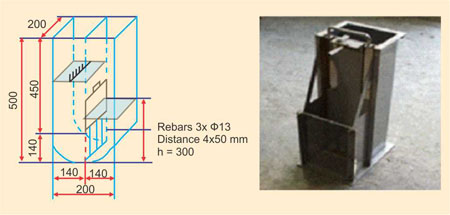
Applications of Self-compacting Concrete
Since the development of the prototype of self-compacting concrete in 1988, the use of self-compacting concrete in actual structures is gradually increasing. The main reasons for its growing application are summarized as follows:- To shorten the construction period
- To assure better compaction in the structure: especially in confined zones where vibration is very difficult
- To assure uniform construction with better quality
- To reduce noise level in the factory as well as on the site
- To reduce personal injuries from noise and manual handling
- To reduce electricity usage at site
- To reduce the overall maintenance of structure
- To save the costs of vibration equipment.
Summary and Outview
Self-compacting concrete is an innovative construction material, which offers various advantages in construction process due to its outstanding characteristics. Considering the economy and the durability of conventional concrete structures, it is observed that the quality and the density of the concrete, as well as the compaction of the concrete are main parameters that cause deterioration. For this, SCC offers new possibilities and prospects. It is a boon considering improvement in concrete quality, significant advances towards automation and concrete construction processes, shortened construction time, lower construction cost, much improved working conditions and is rightly called as a 'silent revolution' in the field of concrete technology.The interpretation of various researches can be summarized as follows:
- The concrete strength of SCC and normal concrete are similar under comparable conditions, this statement includes also the time development of concrete strength,
- Tensile splitting strength, modulus of elasticity and shrinkage of SCC and normal concrete differ, but the differences vary within the usual scatter width, known for normal concrete
- No final tendency can be given for creep of SCC.
Acknowledgment
The author is gratefully acknowledged the help rendered by Mr Abhinav Daharwal and Ms Chanchal Jain of VNIT, Nagpur in preparation of this paper.References
- H Okamura and M Ouchi. 'Self-compacting Concrete-Development, Present use and Future' Proceedings of the First International RILEM Symposium on 'Self-Compacting Concrete'. Sweden, Proc 7, 1999, pp 3-14.
- K Ozawa, M Kunishima, K Maekawa and K Ozawa. 'Development of High Performance Concrete Based on Durability Design of Concrete Structures'. Proceeding of EASEC-2, vol 1, January 1989, pp 445-450.
- F Dehn, K Holschemacher, K and D Weibe. 'Self-Compacting Concrete -Time Development of the Material Properties and the Bond Behaviour'. LACER No 5, 2000, pp 115-124.
- Horst Grube and Jörg Rickert, 'Self Compacting Concrete – Another Stage in the Development of the 5-Component System of Concrete'.
- Okamura, Hajime, Ozawa, and Kazumasa: 'Mix Design for Self-Compacting Concrete' Concrete Library of JSCE No. 25, June 1995.
- Takada, K.; Pelova, G. I.;Walraven, J. C.: Influence of Mixing Efficiency on the Mixture Proportion of General Purpose Self-Compacting Concrete. Int. Symp. on High Performance Concrete and Reactive Powder Concrete. 16.-20. Aug., 1998, Sherbrooke, Canada
- Takada, K.; Pelova, G. I.; Walraven, J. C.: Self-Compacting Concrete Produced by Japanese Method with Dutch Materials. Congress of European Ready Mixed Concrete Organization, ERMCO 98, Lisbon, 23.-26. June 1998
- Tattersall, G. H. : Rheology of Portland Cement Paste. British Journal of AppliedPhysics 6 (1955) Nr. 5, S. 165-167.
- Spanka,G.;Grube,H.;Thielen,G.: Wirkungsmechanismen verflüssigender Betonzusatzmittel. Beton 45 (1995), H. 11, S. 802-808 und H. 12, S. 876-881 ; ebenso Betontechnische Berichte 1995-1997, S. 45-60
- Zhu, W. and Bartos, P.J.M., 2000, 'Application of depth-sensing microindentation testing to study of interfacial transition zone in reinforced concrete', Cement and Concrete Research, 30, pp.1299-1304.
- W Zhu J Quinn & PJM Bartos, aspects of durability of self compacting concrete.
- König, G.; Holschemacher, K.; Dehn, F.; Weiße, D.: Self-Compacting Concrete - Time Development of Material Properties and Bond Behaviour.
- Poceedings of the Second International Symposium on Self-Compacting Concrete, Tokyo, (2001), pp. 507 - 516.
- Klaus Holschemacher & Yvette Klug; A Database for the Evaluation of Hardened Properties of SCC.
- H Okamura and K Ozawa. 'Mix Design for Self-Compacting Concrete'. Concrete Library of JSCE, no 25, June 1995, pp 107-120.
- 'Specification and Guidelines for Self-Compacting Concrete'. EFNARC, Association House, 99 West Street, Farnham, Surrey GU9 7EN, UK, February 2002.
- Ferraris, Browner, Ozyildirim & Daczko; 'workability of self compacting concrete'.
- Hayakawa M, Matsuoka Y, Shindoh T. "Development and Application of superworkable concrete. Proc of Int RILEM workshop on special concretes – workability and mixing, Paisley, Scotland, June. London: E&FN Spon; 1993.p. 891-902.
- Furuya N, Itohiya T, Arima I. Development and application of highly flowing concrete for mass concrete anchorages of Akashi-Kaikyo Bridge. Proc of Int Conf on high performance concrete. Detroit, USA: American Concrete Institute; 1994. P. 371-396.
- de Larrard F, Gillet G, Canitrot B. Preliminary HPC mix design study for the Grand Viaduct de Millau. In: Proc of 4th Int Symp on utilisation of high strength concrete, May Paris France, 1996.p. 1323-331.
- Nishizaki T, Kamada F, Chikamatsu R, Kawashima H. Application of high strength self compacting concrete to prestressed concrete outer tank for LNG storage. Proc of 1st RILEM Int Symp on self compacting concrete, Stockholm. Paris: RILEM; 1999.p. 629-38.
- Botte J, Burdin J, Zermatten M. SCC tunnel applications: Proc of Int RILEM workshop on self compacting concrete, Stockholm. Paris: RILEM; 1999.p. 681-93.
- Inoue H, Takeichi Y, Ohtomo T. Construction of rigid foundation of underground diaphragm wall. In: Proc of 2nd Int Symp on utilisation of SCC, Japan 2001.p. 643-50.
- Johanson K, Kyltveit BP. ScCC in a rock repository for radioactive waste. : Proc of 2nd Int Symp on utilisation of SCC, Tokyo, Japan Oct 2001.p 681-86.
- Fornasier G, Giovambattista P, Zitzer L. SCC in Argentina; development program and application. In:Proc of 1st north American conference on the design and use of SCC, Chicago, Nov 2002. P. 439-44
- Collepardi M, Collepardi S, Ogoumah ologat JJ, troli R.laboratory test and field experiences of high performance SCCs. Proc of 3rd RILEM Int Symp on SCC, Iceland, Aug. France; RILEM publications PRO 33;2003.p. 413-16.
- Jörg Dietz, Jianxin Ma; "Preliminary Examinations for the Production of Self-Compacting Concrete Using Lignite Fly Ash".LACER No.5 – 2000.p.125-140.
- Dr. R. Sri Ravindrarajah, D. Siladyi, B. Adamopoulos; "development of high-strength self-compacting concrete with reduced segregation potential" Poceedings of the 3rd International RILEM Symposium , Reykjavik, Iceland, 17-20 August 2003, Edited by O. Wallevik and I. Nielsson , (RILEM Publications), 1 Vol., 1048 pp.
- K Ozawa, N Sakata and H Okamura. 'Evaluation of Self-Compactibility of Fresh Concrete Using the Funnel Test'. Concrete Library of JSCE, vol 25, June 1995, pp 59-75.
- "The European Guidelines for Self Compacting Concrete" Specification , Production and Use; EFNARC (2005); pp 63.
NBM&CW September 2009



















